AN INTERVIEW WITH DR. ELLIOTT D. BLOOM - PROFESSOR OF PARTICLE PHYSICS AND ASTROPHYSICS, EMERITUS STANFORD

DR. ELLIOTT BLOOM,
Group Leader for Stanford Linear Accelerator Center (SLAC)
Group K- Dr. Bloom studies Particle Astrophysics with emphasis on the measurement of phenomena associated with regions of high field gravity. Such phenomena are associated with neutron star and black hole candidate systems. His work includes space based X-Ray timing and high energy gamma-ray telescopes offer a powerful tool to experimentally probe such objects including current observations with the USA x-ray telescope, and design and construction of the Large Area Gamma-ray Space telescope.
Group K is located at the Stanford Linear Accelerator Center, a part of Stanford University. The major research interests of Group K are in particle astrophysics. This exciting new discipline merges the worlds of particle physics and astrophysics to try to address some of the most fundamental questions about our universe. Particle astrophysicists use high-energy observations of super-massive black holes and other types of cosmic objects in order to: Test the standard model of particle physics under extreme conditions of temperature, density and magnetic field that cannot be reproduced in laboratories; Discover possible new types of elementary particles using powerful astrophysical sources; Test the nature of relativistic gravity in environments which have extreme gravitational fields; and Probe the universe on very short and very long timescales using space-based experiments which detect X- and gamma-radiation.
The Fermi-LAT community has been collecting information about the Universe for 10 years.
Fermi is a powerful gamma ray space observatory that has opened a wide window on the universe. Gamma rays are the highestenergy form of light, and the gamma-ray sky is spectacularly different from the one we perceive with our own eyes. With a huge leap in all key capabilities, Fermi data is enabling scientists to answer persistent questions across a broad range of topics, including super massive black-hole systems, pulsars, the origin of cosmic rays, and searches for signals of new physics. The mission is an astrophysics and particle physics partnership, developed by NASA in collaboration with the U.S. Department of Energy, along with important contributions from academic institutions and partners in France, Germany, Italy, Japan, Sweden, and the United States. Fermi (formerly known as Gamma-ray Large Area Space Telescope, or GLAST) was launched on June 11, 2008. It is named after Enrich Fermi, an Italian-American scientist who did pioneering work in highenergy physics.
Theories of dark matter, mainly invented by Particle Physicists, propose that it is a new sector of matter very different than normal matter
In 1992 a group of physicists at Stanford came up with an idea. They wanted to develop a large telescope to see the entire universe and the gamma ray sky in order to find out more about dark matter. To this day, particle physicists don’t agree on what dark matter is, yet it makes up as much as 90% of matter. With this new Gamma Ray Telescope, the largest ever launched in space, this group of physicists wanted to find out more about dark matter and the hi energy universe we cannot see.After winning an announcement of opportunity from NASA, the GLAST collaboration began, gathering funding from an international team including United States, NASA, DOE and Sweden, Italy, Japan, Germany, & France. Construction took place at the University of CA Santa Cruz and the GLAST (renamed FERMI Gamma Ray Telescope) was launched in 2008.
Now after ten years in space, the scientists have some results. And they have done way beyond what they initially thought they could do.
Viewing 12 billion Years of Starlight with FERMI LAT
The predecessor, EGRET could only view 1,000 sources where the Fermi LAT could record 10,000, thereby viewing a much larger area. In fact, in just one week, orbiting around the Earth every 90 minutes, the FERMI LAT collected more data on gamma rays than all the other studies combined. To put it into perspective, the FERMI LAT can see up to 12 billion light years away, since the formation of the universe began.
Particle Physicists have detected 17 particles and 4 forces, but what FERMI LAT tells us is that there are possibly other particles we haven’t identified and other forces acting on them. From Astro physical energy sources, the SLAC’s linear accelerator cosmic version of hi energy charged particles depict an extremely violent universe. Only 5% of the universe is described by the standard module of particle physics.
“There are a number of ways to look for experimental signatures of dark matter (beside gravitational signatures that is the reason we believe dark matter exists). The Fermi-LAT telescope uses “indirect detection” techniques and another method uses “direct detection”. There is a third method that is exemplified by searches for dark matter at the Large Hadron Collider (LHC) at the CERN lab in Switzerland. The LCH searches for dark matter by attempting to produce it using its high energy circulating beams of protons in proton-proton collisions. Except for indications from gravitational interactions, all of these techniques have so far come up empty with no observation of dark matter, just limits. Currently, theory indicates that we should be searching using all three experimental techniques as one or the other may be more sensitive, though unpredictably so.” Dr. Elliott Bloom, Professor of Particle Physics and Astrophysics, Emeritus Stanford
Dark Matter, the Invisible Component. The one that does not emit light remains for the most part a mystery, but FERMI LAT can tell you a lot about it.
The largest all sky telescope, Fermi has answered persistent questions about super massive blackhole systems, pulsars, the origin of cosmic rays, and searches for signals of new physics. Dr. Eric Charles who has been on the project since 2005, three years before it launched said that he came to the project because it was a new kind of telescope and incredibly appealing.
Our eyes have evolved to create a view that makes sense, but there is so much more to see. In his recent talk at SLAC “10 Years of Cosmic Fireworks with FERMI”, he presents five of the highlights of the mission ranging from terrestrial gamma ray flashes and from the sun to measuring all the starlight in the universe. Gamma Rays are electromagnetic short wave lengths with lots of energy at a very high frequency, 1/billionth of an atom at 2 trillion degrees Celsius. Gamma Rays which have billion electron volts are formed by the accelerating hi energy charged particles and are visible with the FERMI LAT.
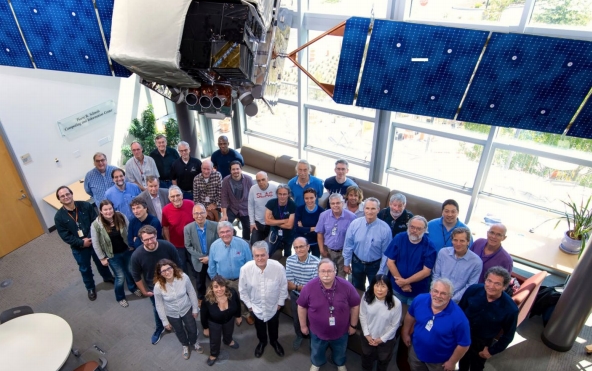
The hi energy universe was dramatically influenced by FERMI in the last 10 years, thru FERMI we have learned a lot about pulsars, states Dr. Bloom
Pulsars are rapidly spinning neutron stars, super dense objects forged when a massive star collapses and explodes as a supernova. Young neutron stars spin dozens of times a second and gradually slow with age. But if an aging pulsar is paired with a normal star in a binary system, their interaction may ramp up the neutron star’s spin to hundreds of rotations each second, creating what astronomers call a millisecond pulsar. Dizzying spin coupled with super strong magnetic and electric fields make pulsars superb natural particle accelerators, nearly 1,000 times more powerful than any machine on Earth. Originally discovered nearly 50 years ago by their radio emissions, more than 2,000 pulsars have been identified to date. Radio telescopes - and later, satellite
with detectors sensitive to X-rays and gamma rays - detect a quick pulse whenever a pulsar’s rotation sweeps its beam of emission across our field of view.
With a big budget increase for particle physics this year (800 million), future scientists searching for answers to the mysterious dark matter can go back to fundamental science says Dr. Bloom. Applied science was doing very well, he says, but science was dying. Fundamental science is the long term. “Since we don’t know what dark matter is, and it does look like some kind of matter - that’s the excitement of science.”
Some Fermi-LAT Collaboration members gathered at the SLAC National Accelerator Laboratory on the 10th anniversary of the Fermi Gamma-ray Space Telescope (FGST) on June 11, 2018
The LAT collaboration includes more than 400 scientists and students at more than 90 universities and laboratories in 12 countries.
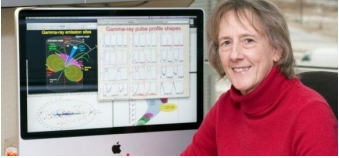
Above: Alice Harding studies how gamma-ray pulsars work using observations from NASA’s Fermi GammaRay Space Telescope
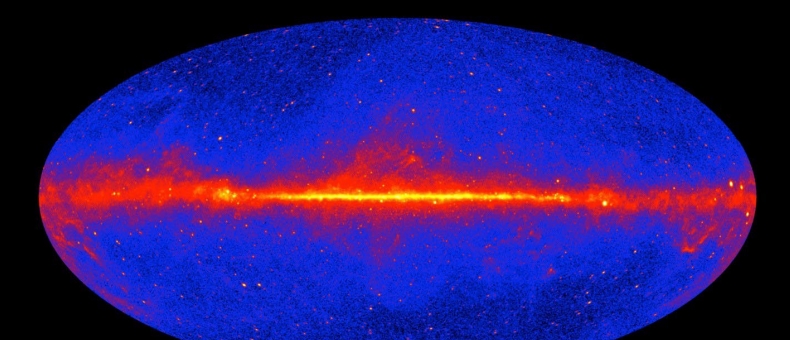
ALL SKY INTENSITY MAP DERIVED FROM 9 YEARS OF FERMI-LAT DATA SHOWS THE ENTIRE UNIVERSE
This picture is an all sky intensity map derived from 9 years of Fermi-LAT data, (August 4, 2008 - August 4, 2017) time integrated all-sky image (based on Pass 8 Source class, PSF3 event type-internal collaboration notation). The map is also integrated above 1 GeV (that is 1 billion electron volt energy gamma rays and above up to about 1 trillion electron volt energy). The intensity scale is false color with low intensity black and high intensity white. The map shows the entire universe in standard astronomical Galactic coordinates (in what is called a Hammer-Aitoff projection – not simple), these coordinates and projection have the center of our galaxy at the center of the picture (very bright), and the anticenter of the galaxy at the edges of the picture centerline (the anticenter is in the direction out from the Galactic center along the Galactic center-sun axis) The images are smoothed with a 0.25 deg FWHM Gaussian. The maps are in intensity units. The images have a logarithmic scaling, from about 3 x 10-7 gamma rays per cm-2 s-1 sr-1 to 1 x 10-3 gamma rays per cm-2 s-1 sr-1. The actual maximum intensity in the map is 0.02 cm-2 s-1 sr-1. (cm-2 is per square centimeter of detector area, s-1 is per sec and sr-1 is per steradian). The images are 3600x1800 (0.1 degree pixels). The bright dots are point sources of gamma rays in the sky, and many of these are time variable that you don’t notice in this time lapse image. The band that you see horizontally across the picture is the Milky Way Galaxy (our galaxy). Above this plane and below this plane are gamma ray sources from the rest of the universe and typically many millions to billions of light years away from us. Not so obvious in this picture are the “Fermi Bubbles” the diffuse structures that protrude above and below the region of the Galactic center. These structures are thought to be remnants of energetic jet activity powered by the central black hole of our galaxy in times long past and were discovered using Fermi-LAT data. Photo Credit: Fermi-LAT Collaboration
PICTURE SERIES INDICATING HOW WE DECOMPOSE THE GAMMA RAY SKY
(Photos and Captions provided by Dr. Elliott Bloom, Fermi-LAT)
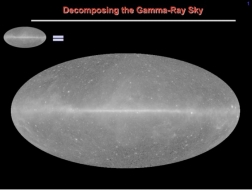
Picture 1: All-Sky intensity in black and white
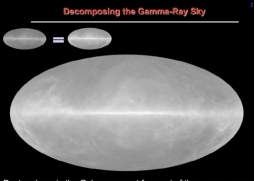
Picture 2: Diffuse - in a complex analysis we can isolate the Galactic diffuse signal and it looks as in this picture.This gamma ray signal mostly originates in the interaction of Galactic cosmic rays with the gas of the Galaxy.
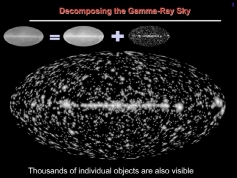
Picture 3: Point sources - In different complex analysis we can extract
the point and near point sources of gamma rays.
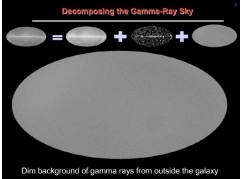
Picture 4: Extra Galactic diffuse – In yet a different complex analysis we can extract the diffuse gamma ray radiation coming from beyond our galaxy,
likely from the furthest reaches of the universe. This diffuse is uniform from all directions.
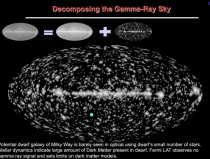
Picture 5: Use Dwarf Galaxies to search for dark matter - This picture is similar to the point sources in which I try to demonstrate how we can set limits on gamma rays coming from dark matter particle decay or annihilationwith another DM particle.
There are now about 60 dwarf satellite galaxies of the Milky Way that have been discovered and new ones are discovered every year via ground based optical telescope surveys of the sky. One can measure from the stellar motions in these galaxies using big optical telescopes that they are heavily dark matter dominated.
Looking for Dark Matter by Observing Dwarf Galaxies
Dark matter makes up about 28% of the matter in the universe. Regular matter that we are used to makes up about 5% of the matter in the universe. The rest of the energy density of the universe is made up of dark energy. Thus about 80% of the matter in the universe is of a very different kind than the matter we know about-all of the elements of the periodic table, and does not shine so we can see it in any kind of EM radiation from radio to gamma rays. Theories of dark matter, mainly invented by Particle Physicists, propose that it is a new sector of matter very different than normal matter. What is it?
The Fermi-LAT community has be searching for emission of gamma -rays from dark matter that has been predicted by theoretical models of what might make up the dark matter (new types of elementary particles).
This last picture shows as a green dot a hypothetical dwarf galaxy located where there are no gamma ray point sources (this is typical in our data, though this sky location is hypothetical). Optical telescopes would measure the presence of a small galaxy with not too many stars, and also indicate that the dwarf galaxy was dark matter dominated.
Fermi knows where to look as the optical telescopes precisely establish the location of this dwarf galaxy. When the Fermi – LAT does its observations and analysis of this spot it finds no emission of gamma-rays, and then we can set limits on the gamma ray intensity from this dwarf. These limits challenge theories of particle dark matter that predict the Fermi-LAT should have observed gamma-rays from this source. There are a number of other ways that the Fermi – LAT can search for dark matter gamma ray signals, but using dwarf galaxies has proven so far to give the most stringent limits on dark matter gamma ray emission.
New Search Underway for the Dark Matter at SLAC
Scientists know that visible matter in the universe accounts for only about 15% of all matter and the rest is a mysterious substance, called dark matter. Due to its gravitational pull on regular matter, dark matter is a key driver for the evolution of the universe, affecting the formation of galaxies like the Milky Way. Still searching for what dark matter is made of, scientists at SLAC believe it could be composed of dark matter particles, and WIMPs are top contenders. If these particles exist, they would barely interact with their environment and fly right through regular matter untouched. However, every so often, they could collide with an atom of our visible world, and dark matter researchers are looking for these rare interactions.
Construction Begins on One of the World’s Most Sensitive Dark Matter Experiments
The SuperCDMS SNOLAB project, a multiinstitutional effort led by SLAC, is expanding the hunt for dark matter to particles with properties not accessible to any other experiment.
U.S. Department of Energy funded the construction of SuperCDMS SNOLAB experiment, which will begin operations in the early 2020s to hunt for hypothetical dark matter particles called weakly interacting massive particles, or WIMPs. The DOE Office of Science will contribute $19 million to the effort, joining forces with the National Science Foundation ($12 million) and the Canada Foundation for Innovation ($3 million). The DOE’s SLAC National Accelerator Laboratory is managing the construction project for the international SuperCDMS collaboration of 111 members from 26 institutions, which is preparing to do research with the experiment.
The experiment will be at least 50 times more sensitive than its predecessor, exploring WIMP properties that can’t be probed by other experiments and giving researchers a powerful new tool to understand one of the biggest mysteries of modern physics, what is dark matter?
“Understanding dark matter is one of the hottest research topics – at SLAC and around the world,” said JoAnne Hewett, head of SLAC’s Fundamental Physics Directorate and the lab’s chief research officer. “We're excited to lead the project and work with our partners to build this next-generation dark matter experiment.”
